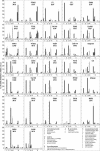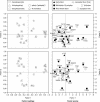High genetic variability of herbivore-induced volatile emission within a broad range of maize inbred lines
- PMID: 15299140
- PMCID: PMC520764
- DOI: 10.1104/pp.104.039891
High genetic variability of herbivore-induced volatile emission within a broad range of maize inbred lines
Abstract
Maize plants (Zea mays) attacked by caterpillars release a mixture of odorous compounds that attract parasitic wasps, natural enemies of the herbivores. We assessed the genetic variability of these induced volatile emissions among 31 maize inbred lines representing a broad range of genetic diversity used by breeders in Europe and North America. Odors were collected from young plants that had been induced by injecting them with caterpillar regurgitant. Significant variation among lines was found for all 23 volatile compounds included in the analysis: the lines differed enormously in the total amount of volatiles emitted and showed highly variable odor profiles distinctive of each genotype. Principal component analysis performed on the relative quantities of particular compounds within the blend revealed clusters of highly correlated volatiles, which may share common metabolic pathways. European and American lines belonging to established heterotic groups were loosely separated from each other, with the most clear-cut difference in the typical release of (E)-beta-caryophyllene by European lines. There was no correlation between the distances among the lines based on their odor profiles and their respective genetic distances previously assessed by neutral RFLP markers. This most comprehensive study to date on intraspecific variation in induced odor emission by maize plants provides a further example of the remarkably high genetic diversity conserved within this important crop plant. A better understanding of the genetic control of induced odor emissions may help in the development of maize varieties particularly attractive to parasitoids and other biological control agents and perhaps more repellent for herbivores.
Figures



Similar articles
-
Differential attractiveness of induced odors emitted by eight maize varieties for the parasitoid cotesia marginiventris: is quality or quantity important?J Chem Ecol. 2002 May;28(5):951-68. doi: 10.1023/a:1015253600083. J Chem Ecol. 2002. PMID: 12049233
-
Fungal infection reduces herbivore-induced plant volatiles of maize but does not affect naïve parasitoids.J Chem Ecol. 2006 Sep;32(9):1897-909. doi: 10.1007/s10886-006-9147-3. Epub 2006 Aug 11. J Chem Ecol. 2006. PMID: 16902818
-
Induction of volatile emissions in maize by different larval instars of Spodoptera littoralis.J Chem Ecol. 2003 Jan;29(1):145-62. doi: 10.1023/a:1021984715420. J Chem Ecol. 2003. PMID: 12647859
-
Attraction of parasitic wasps by caterpillar-damaged plants.Novartis Found Symp. 1999;223:21-32; discussion 32-8. doi: 10.1002/9780470515679.ch3. Novartis Found Symp. 1999. PMID: 10549546 Review.
-
Biosynthesis and function of terpenoid defense compounds in maize (Zea mays).Planta. 2019 Jan;249(1):21-30. doi: 10.1007/s00425-018-2999-2. Epub 2018 Sep 6. Planta. 2019. PMID: 30187155 Review.
Cited by
-
Responses of Trichogramma pretiosum (Hymenoptera: Trichogrammatidae) to Rice and Corn Plants, Fed and Oviposited by Spodoptera frugiperda (Lepidoptera: Noctuidae).Neotrop Entomol. 2021 Oct;50(5):697-705. doi: 10.1007/s13744-021-00876-0. Epub 2021 Apr 28. Neotrop Entomol. 2021. PMID: 33909277
-
Green Lacewing Chrysoperla externa Is Attracted to Volatile Organic Compounds and Essential Oils Extracted from Eucalyptus urograndis Leaves.Plants (Basel). 2024 Aug 8;13(16):2192. doi: 10.3390/plants13162192. Plants (Basel). 2024. PMID: 39204628 Free PMC article.
-
Chemical Ecology of the host searching behavior in an Egg Parasitoid: are Common Chemical Cues exploited to locate hosts in Taxonomically Distant Plant Species?J Chem Ecol. 2022 Aug;48(7-8):650-659. doi: 10.1007/s10886-022-01373-3. Epub 2022 Aug 3. J Chem Ecol. 2022. PMID: 35921017
-
Herbivore-induced plant volatiles to enhance biological control in agriculture.Neotrop Entomol. 2013 Aug;42(4):331-43. doi: 10.1007/s13744-013-0147-z. Epub 2013 Jul 10. Neotrop Entomol. 2013. PMID: 23949852 Review.
-
Strong oviposition preference for Bt over non-Bt maize in Spodoptera frugiperda and its implications for the evolution of resistance.BMC Biol. 2014 Jun 16;12:48. doi: 10.1186/1741-7007-12-48. BMC Biol. 2014. PMID: 24935031 Free PMC article.
References
-
- Alborn T, Turlings TCJ, Jones TH, Stenhagen G, Loughrin JH, Tumlinson JH (1997) An elicitor of plant volatiles from beet armyworm oral secretion. Science 276: 945–949
-
- Bernasconi Ockroy ML, Turlings TCJ, Edwards PJ, Fritzsche-Hoballah ME, Ambrosetti L, Bassetti P, Dorn S (2001) Response of natural populations of predators and parasitoids to artificially induced volatile emissions in maize plants (Zea mays L.). Agric For Entomol 3: 201–209
-
- Boland W, Koch T, Krumm T, Piel J, Jux A (1999) Induced biosynthesis of insect semiochemicals in plants. In DJ Chadwick, JA Goode, eds, Insect-Plant Interactions and Induced Plant Defence, Novartis Foundation Symposium 223, October 13–15, 1998, London. John Wiley & Sons, Chichester, UK, pp 110–131 - PubMed
-
- Bottrell DG, Barbosa P, Gould F (1998) Manipulating natural enemies by plant variety selection and modification: a realistic strategy? Annu Rev Entomol 43: 347–367 - PubMed
-
- Burstin J, de Vienne D, Dubreuil P, Damerval C (1994) Molecular markers and protein quantities as genetic descriptors in maize. I. Genetic diversity among 21 inbred lines. Theor Appl Genet 89: 943–950 - PubMed
MeSH terms
LinkOut - more resources
Full Text Sources
Other Literature Sources

